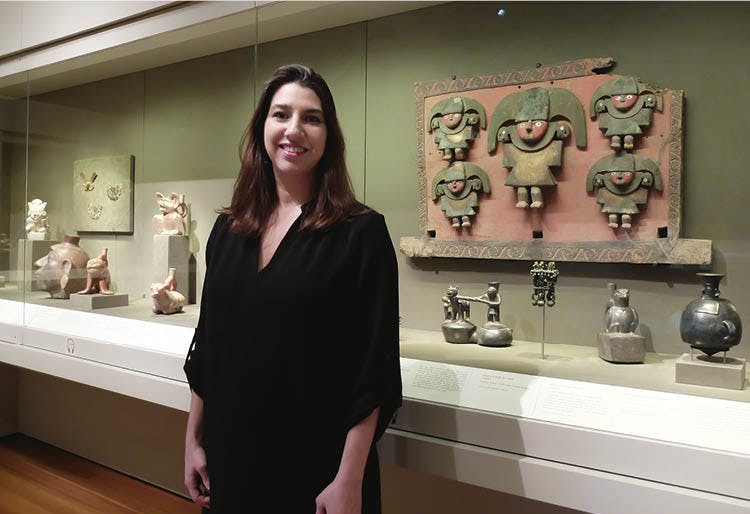
- Magazine Article
- Support
Exploring the Americas
An endowed fellowship bolsters the museum's scholarly mission

Andrea Vazquez de Arthur
As a young girl, Andrea Vazquez de Arthur took art classes at the Cleveland Museum of Art and attended jazz concerts in its courtyard. “My dad would bring me here often on the weekends,” she says. “The African and Native American masks really stood out.”
She is still studying the art of the Americas at the museum. Since July 2018, she has worked as the museum’s first Mary and Leigh Carter Director’s Research Fellow. “Art from the ancient Americas has been on the margins of art history, but it’s booming now, especially Andean art,” she says. “What’s known about the field is growing quickly. New archaeological discoveries are made regularly, so it’s a dynamic, lively field.”
The fellowship is the latest collaboration in an eight-year friendship between Vazquez de Arthur and Wari expert Susan E. Bergh, chair of the CMA’s Department of the Art of Africa and the Americas and curator of Pre-Columbian and Native North American art. “We’re organizing a major show about the ancient Chimú Empire of Peru’s north coast, and Andrea has shouldered responsibility for organizing and investigating the corpus of Chimú ceramics, which are understudied,” says Bergh, who supervises the fellowship. “She’s done a wonderful job exploring key issues, and she’ll eventually contribute to the catalogue. She’s also been participating in the department’s daily life, since a component of the fellowship is to expose the recipients to museum work and to groom them for museum careers.”
Board member Leigh H. Carter, son of the late Mary and Leigh Carter, remembers that his mom was always fascinated by young people, while his dad was interested in being a mentor. “They wanted to have an effect not only on the work of an established professional,” he says, “but also on a person early in their career, like Andrea.”
Vazquez de Arthur’s parents moved from Mexico to Cleveland in the 1970s. After earning a bachelors degree in graphic design at the Rhode Island School of Design in 2001, she was encouraged by a friend to backpack in Costa Rica. “I was terrified,” she says, “but I realized it’s important to get out of your comfort zone. One week in, I called my parents and said I wasn’t coming back.” She traveled to ancient ruins in Mexico and Guatemala and spent three years hiking through Central and South America.
“Peru blew my mind,” she says. “The landscape is so dramatic. In the highlands, immersed in the architecture and culture of Cuzco’s historic district, it felt like being in another time. Outside Cuzco the city, I found that you don’t have to go far off the beaten path to experience a different way of life.”
After returning to the States, Vazquez de Arthur began a master’s degree in art history at Columbia University in 2007, later interning with Bergh for six weeks in the summer of 2012 to help prepare Wari: Lords of the Ancient Andes, the first exhibition in North America to focus on the Wari Empire of ancient Peru (AD 600–1000). In September 2019 she defended her PhD dissertation, “Portraits, Pots, or Power Objects? On the Imagery and Ontology of Wari Faceneck Vessels.”
Vazquez de Arthur and her husband moved to Cincinnati in 2015 for his work; a baby came in 2017. Then Bergh called to discuss how a research fellowship endowed by the Carters could benefit an upcoming Chimú exhibition.
“My dad wanted to contribute something that connected to the erudition and the scholarly aspects of the museum,” Carter says. “Rather than being about the building or a piece of art, this gift would continue to enhance the scholarly reputation of the Cleveland Museum of Art. My dad was absolutely in love with the library at the museum. It’s one of the finest art libraries in the world. This fellowship was a way to tie into the library and to the idea that the museum is a place for scholarly study, not just a display area.”
“Andrea and I are very grateful to Leigh Carter for endowing the fellowship,” says Bergh. “He was an old friend and I admired him, not least because of what I read about his maverick business savvy in the newspapers. I miss him.”
“Working on a groundbreaking exhibition about a culture that is not well understood was an amazing opportunity that I couldn’t pass up,” Vazquez de Arthur says. “It was early enough in the planning process for research to make a big impact on shaping the exhibition’s major themes.”
Previous archaeological research on the Chimú has not always focused on objects; the close study of artifacts and images is what art historians can offer. “Archaeologists tend to take a broader approach toward understanding cultural development,” she says. “But we can look closely at Chimú metalwork and ceramics and find significant connections to neighboring cultures. There are nuances that the careful study of artworks can provide.”
“It’s crucial to have research assistance when taking on a major project like this,” Bergh says. “It hasn’t been done before, it has many moving parts, and from time to time the scope can be overwhelming. But it’s the kind of research that reminds you why you became an art historian: you’re looking closely at objects to see what they will tell you about ancient peoples and their interesting ways of thinking.”

Cleveland Art, March/April 2020